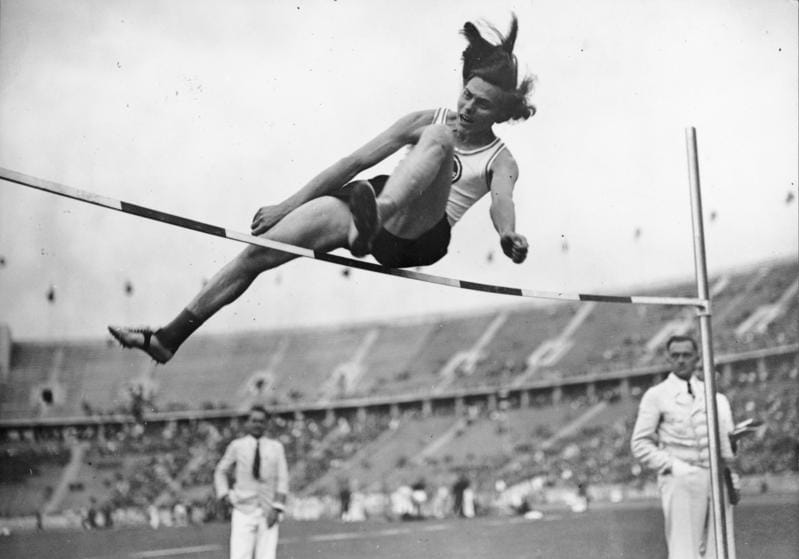When Dora Ratjen was discovered on 21 September 1938 on her way home by train to Germany from Vienna after setting the world record in the high jump at 1.70 meters in women’s category, she breathed a sigh of relief: she was tired of pretending. Because Dora Ratjen was not a she, but a he.
On the day the truth came out, Dora was wearing thin tights to match her light-colored shoes and a sober grey suit.
Despite being dressed appropriately for the time, Dora raised other travelers’ suspicion that something was amiss. Let’s find out the entire story of Dora Ratjen, the man who competed as a woman at the Berlin Olympics.
In 1936, the Summer Olympics were held in Berlin. They would go down in history as the “Nazi Olympics”, during which many controversies surrounding the politics of the Third Reich caught the world’s attention. While Hitler considered the Olympics as a means of promoting his idea of pure German superiority, his plan did not work out as originally intended – mainly due to Jesse Owens, an African American athlete who won four gold medals, shattering Hitler’s concept.
On the other hand, a problem that went unmentioned during the Olympics was brought to light two years later as an oddity (as it was called at the time) that led to the termination of a competitor’s athletic career. The “oddity” in question was Dora Ratjen, “an athlete of German origin”, whose appearance prompted a train conductor to report to the police that “a man dressed as a woman” was on the train he was driving.

This happened on 21 September 1938 in Magdeburg, Germany, as Ratjen was traveling back to Cologne. Ratjen had just returned from the European Athletics Championships, where she had won a gold medal and set a world record in the women’s high jump.
Just two years before this incident, at the 1936 Olympics, she had won fourth place in the women’s high jump, without anyone suspecting that she was actually a man. However, when Dora was detained, she decided to tell the police the full story after they threatened to strip her naked and forcibly examine her.
A series of questions followed and her father, Heinrich, gave the following statement to the police: “I was not sitting by my wife’s bed during the birth; I was in the kitchen at the time. When the baby was born, the midwife said to me, “Heinrich, it’s a boy!” But five minutes later she told me, “No, wait, it’s a girl.” So, the baby was registered with the first name Dora.
As for her appearance, it was not uncommon at the time for female athletes to have physical features that could be described as “masculine”, such as more prominent muscles and a thicker voice.
Dora confessed to police that she was a man, although he had been raised as a girl. “My parents raised me as a girl. Therefore, I wore girls’ clothes all my childhood. But from the age of 10 or 11 I started to realize that I was not a woman, but a man. However, I never asked my parents why I had to wear women’s clothes, even though I was a man.”
The transcript of the interrogation was uncovered by the German newspaper Der Spiegel, which published an article in 2009, bringing to light Dora Ratjen’s forgotten case. Although one might think Dora was reluctant to talk about her situation, according to police records the man who competed as a woman at the Berlin Olympics showed relief when he recounted hiding his true identity from other athletes.

After the confession, it was a doctor who established and told officials that Dora Ratjen was a man. Although he was certain that the person was male, he noticed that there was an anatomical abnormality, resembling scar tissue, around the lower part of the male genital organ. He concluded that this anomaly most likely misled Ratjen’s parents, who were not sure whether Dora was a girl or a boy.
As soon as this was confirmed, the following news was broadcast on a Berlin radio station: “The European show jumping champion in female category, Ratjen, bearing the first name Dora, is not a woman, but a man. Please inform the Reich Ministry of Sport immediately.”
Soon after, Dora was banned from participating in other sporting events and all her medals were confiscated.
After all that, Dora, was named Heinrich, was given a new identity card and work documents, and sent to Hanover “as a worker”. Later, he inherited his parents’ bar and led a solitary life, away from the eyes of journalists.
However, controversy arose following a 1966 Time magazine article that claimed Ratjen had been hired by the Nazi Party to pose as a woman during the 1936 Olympics. The scandal escalated when Gretel Bergmann, Heinrich’s former teammate, supported the claim.
Bergmann was an athlete of German-Jewish descent who was kicked off the team just before the 1936 Olympics began because of her connection to Jewish people. Bergmann then emigrated to the United States in 1937, where she lived until her death in 2008.
While there is no doubt that Bergmann was denied the right to compete because of horrible Nazi laws, according to a 2009 article published in Der Spiegel, the claim that Dora/Heinrich Ratjen was introduced to replace the Jewish athlete is false.

